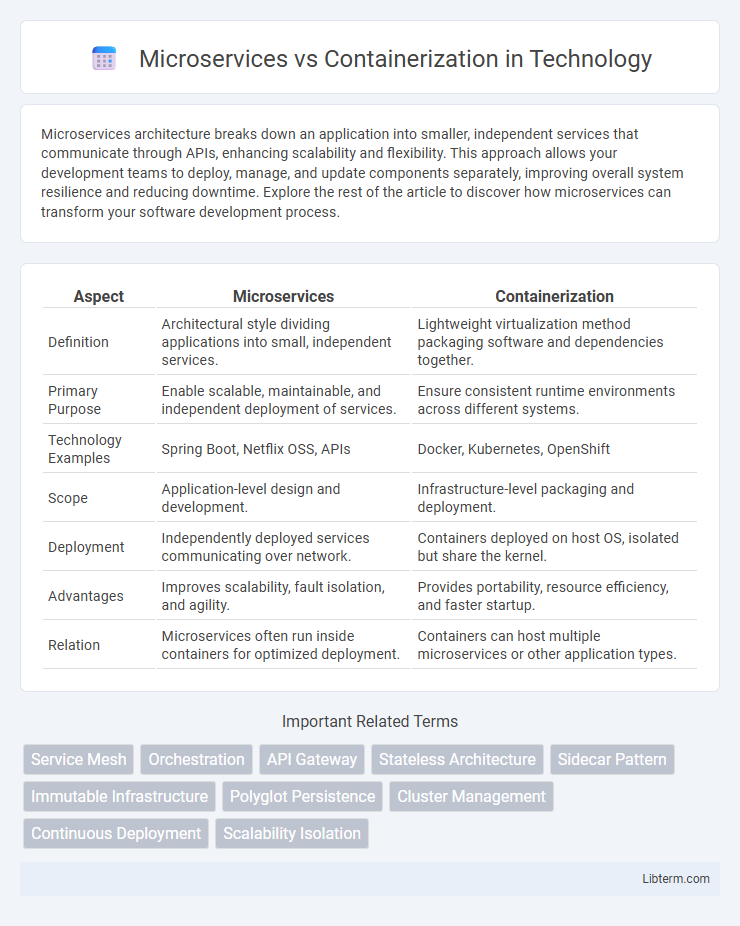Microservices architecture breaks down an application into smaller, independent services that communicate through APIs, enhancing scalability and flexibility. This approach allows your development teams to deploy, manage, and update components separately, improving overall system resilience and reducing downtime. Explore the rest of the article to discover how microservices can transform your software development process.
Table of Comparison
| Aspect | Microservices | Containerization |
|---|---|---|
| Definition | Architectural style dividing applications into small, independent services. | Lightweight virtualization method packaging software and dependencies together. |
| Primary Purpose | Enable scalable, maintainable, and independent deployment of services. | Ensure consistent runtime environments across different systems. |
| Technology Examples | Spring Boot, Netflix OSS, APIs | Docker, Kubernetes, OpenShift |
| Scope | Application-level design and development. | Infrastructure-level packaging and deployment. |
| Deployment | Independently deployed services communicating over network. | Containers deployed on host OS, isolated but share the kernel. |
| Advantages | Improves scalability, fault isolation, and agility. | Provides portability, resource efficiency, and faster startup. |
| Relation | Microservices often run inside containers for optimized deployment. | Containers can host multiple microservices or other application types. |
Introduction to Microservices and Containerization
Microservices architecture breaks down applications into small, independent services that communicate through APIs, enabling scalability and faster deployment. Containerization uses lightweight, portable containers to package these microservices with their dependencies, ensuring consistent environments across development, testing, and production. Combining microservices with containerization enhances application flexibility, resilience, and efficient resource utilization.
Core Concepts: Microservices Explained
Microservices architecture breaks down applications into small, independent services that focus on specific business functions, enhancing modularity and scalability. Each microservice can be developed, deployed, and scaled independently, allowing for flexible maintenance and faster updates. This approach contrasts with monolithic architectures by promoting loose coupling and enabling teams to use diverse technologies tailored to each service's requirements.
Understanding Containerization Technology
Containerization technology encapsulates applications and their dependencies into lightweight, portable containers, enabling consistent performance across various environments. Unlike microservices, which decompose applications into discrete services, containerization provides the infrastructure to deploy and manage these services efficiently. Key technologies like Docker and Kubernetes facilitate container orchestration, scalability, and isolation, enhancing deployment speed and resource utilization.
Key Differences Between Microservices and Containers
Microservices architecture divides an application into independent, loosely coupled services designed to perform specific business functions, enabling agile development and scalability. Containerization packages these microservices or any applications with their dependencies into lightweight, portable units that can run consistently across different environments. While microservices define the design and development approach, containers provide the environment and infrastructure for deploying and managing these services efficiently.
Advantages of Microservices Architecture
Microservices architecture enhances scalability by allowing individual components to be developed, deployed, and maintained independently, reducing time-to-market for new features. It improves fault isolation, as failures in one service do not affect the entire application, increasing system resilience. This architecture enables technology diversity, permitting teams to use the best tools and languages suited for each specific service.
Benefits of Containerization in Modern Development
Containerization offers significant benefits in modern development by enabling lightweight, portable, and consistent runtime environments across different stages from development to production. It streamlines application deployment and scaling, allowing microservices to run independently while sharing the host system's kernel, which enhances resource efficiency and reduces overhead compared to traditional virtual machines. Container orchestration tools like Kubernetes further improve resilience, load balancing, and automated scaling, making containerization a critical technology for agile and DevOps-driven workflows.
Challenges in Implementing Microservices
Implementing microservices presents challenges such as managing distributed system complexity, ensuring reliable inter-service communication, and handling data consistency across services. Developers also face difficulties with deployment automation, monitoring, and debugging in a microservices architecture due to the increased number of components. Containerization can mitigate some of these issues by providing standardized environments and easier management but does not eliminate the inherent complexity of microservices design and coordination.
Limitations and Drawbacks of Containerization
Containerization faces limitations such as potential security vulnerabilities due to shared kernel usage, leading to increased risk of container escapes and unauthorized access. Performance overhead can occur when running multiple containers on a single host, impacting resource allocation and scalability. Furthermore, complex orchestration and management require specialized tools like Kubernetes, which can introduce operational challenges and steep learning curves for development teams.
Integrating Microservices with Containers
Integrating microservices with containers enhances application scalability and deployment efficiency by packaging each microservice into isolated, lightweight containers using technologies like Docker and Kubernetes. This combination ensures consistent environments across development, testing, and production, enabling seamless updates and rapid scaling of individual microservices without impacting the entire system. Container orchestration platforms automate management tasks, facilitating fault tolerance and load balancing crucial for microservice architectures.
Choosing the Right Approach: Microservices, Containers, or Both?
Selecting the right approach between microservices and containerization depends on your application architecture and deployment needs. Microservices enable modular development and scalability by breaking applications into independent services, while containers provide lightweight, consistent environments for deploying applications and their dependencies. Combining microservices with containers maximizes flexibility and efficiency, allowing seamless scaling and simplified management across diverse infrastructures.
Microservices Infographic

 libterm.com
libterm.com